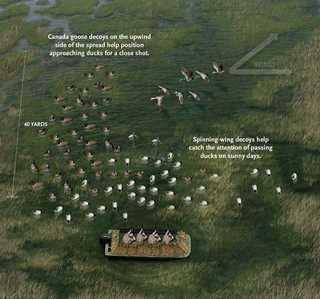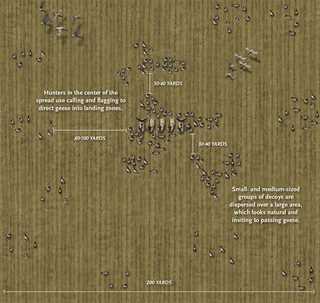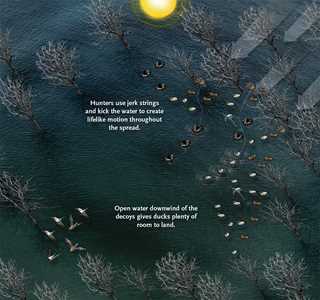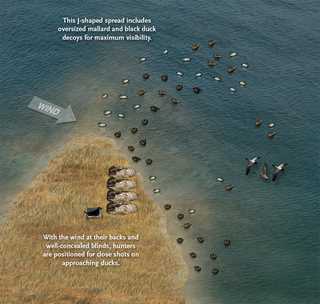Hunting Five Classic Habitats
Tips from the pros on how to hunt these traditional duck and goose hot spots
Tips from the pros on how to hunt these traditional duck and goose hot spots
By John Pollmann
Illustrations by Kevin Hand
As waterfowl hunters, we enjoy a sport rich with traditions passed down from generation to generation. Fittingly, the ducks and geese have traditions of their own, including certain habitats up and down the flyways that they return to again and again. Experienced waterfowl hunters know where to find these special marshes, creeks, fields, timber holes, and points, and they have spent years learning how to hunt them successfully. Here, five experts share their approaches to hunting these time-honored duck and goose venues, helping you put more birds on your strap and creating legendary stories that keep our traditions alive.

For nearly three decades, Barnie Calef's setup of choice for shooting ducks and geese over a marsh has looked exactly the same: a large combination spread of decoys set at a right angle in front of the blind. "It's not a J shape, it's a giant L, and it's based on years of observing mallards landing at the edge of concentrations of birds," says Calef, a three-time world duck calling champion and Drake Waterfowl Elite Team member. "And it's designed to position birds for a shot."
Calef notes that it is important that the Canada goose decoys be on the upwind arm of the L, as the larger decoys tend to act as a sort of backstop, which puts the ducks right in front of the blind. "I've shot lots of Canada geese over this spread, too, though it seems that they won't land quite as tight as the mallards, but it's the difference between a 15-yard shot and a 25-yard shot," Calef says. "They're still in the hole."
Whether hunting from a boat or a blind, Calef says he ideally wants to have the sun and the wind behind him. He places spinning-wing decoys in the landing hole when there is sun. Under cloudy skies, he typically uses Higdon Pulsators to create movement in the decoys. "This is a setup that I've used a lot on the marsh, but really I'll use it anywhere there is enough room for both the duck and Canada goose decoys," he says.

Cover Up
Natural vegetation along the creek bank can help hide the blind.
The Platte River in western Nebraska attracts large numbers of waterfowl each fall, but at certain times of the season, the birds and hunters turn their attention to the region's warm-water creeks. "Especially on those cold, snowy, or windy days, birds are getting up off the river and looking for protection in the smaller creeks," says Ross Juelfs, a guide at Cheyenne Ridge North Platte Outpost near Scottsbluff. "But even on mild days, we will often hunt the creeks, setting up close to where they dump into the river, and we'll run traffic on those ducks flying the main channel."
The creeks that Juelfs hunts are often only about 15 yards wide, allowing for the use of a smaller decoy spread. With heavy vegetation along the banks, however, he makes sure his decoys are visible. "I incorporate full-body mallards when possible for a different look and also a number of black duck decoys to help the spread stand out, and I've also started experimenting with using fully flocked floating decoys," Juelfs explains. "The toughest days you have in the field are those gray, cloudy, flat days, and while using the fully flocked decoys doesn't solve all the problems, it does seem like that added level of realism helps."
Motion in the spread is also important, and Juelfs uses a pair of splasher-style decoys in the middle of the landing hole to create movement on the water and in the decoys. "Calling plays a role, too, in getting the attention of ducks in these tight spots, and I'll be a little more aggressive if I'm losing the birds to other stretches of the creek," Juelfs says.
Juelfs's creek hunts most often involve permanent blinds, which are purposely located 10 to 20 yards from the edge of the water-something he recommends that hunters using mobile blinds also keep in mind. "Positioning those blinds back off the water helps keep the birds from focusing on the hunters, and it's a smart thing to do if that little extra distance allows you to take advantage of better cover for concealment," Juelfs advises. "Remember, too, that you're dealing with a pretty narrow band of water, so you don't need to be right on top of your decoys to have shots well within range."

Spaced Out
This spread includes multiple groups of decoys with plenty of space between them. Geese can approach and land from many different angles.
Colorado hunter Bill Schaefer rarely sees Canada geese resting or feeding in a field with uniform spacing among the birds or with birds grouped together tightly in a recognizable shape. "That's the trap we fall into as hunters putting out the decoys," says Schaefer, owner and guide of High Desert Waterfowl, based in Grand Junction. "We get too worried about spreading out our decoys too much or having them too far from the blind, because we think we won't be able to control the birds and put them in the hole. I try to do the opposite by adding depth and width to the spread. Then I use motion and calling to work them in close for a shot."
While more decoys can be used, Schaefer typically puts out anywhere from six dozen to 10 dozen and leaves more space between individual decoys the farther he is from the blind. He creates multiple pockets of space within shooting range in front, behind, and on either side of the blind to give the birds the opportunity to land from several different angles.
"The space gives you a chance to be able to work the birds within the spread, but on days with little or no wind, you don't have anything helping you create an urgency to land," Schaefer says. "That's where a combination of calling and flagging comes into play. I call sparingly when the birds are above the blind, but I'm more aggressive when they're on the corners. It's a similar approach with the flag-I create just enough movement to keep them interested, but not so much that they can pick me out."
Staying concealed is Schaefer's top priority. "It's really one of the only factors you can control," he says. "Take the time and effort to do it properly."
For hunters in a pit blind, this means replacing cover that is lost to weather, hunters getting in and out of the blind, and dogs making retrieves. "If you're hunting out of a layout blind, it helps to be able to set it up the night before, particularly in colder temperatures, so your blind has a layer of frost on it like everything else in the field. When brushing the blind, you can underdo it and you can overdo it. Keep it realistic and only use cover from the field," Schaefer says.

Play the Shadows
On sunny days in the timber, hunters rely on shadows for concealment.
The flooded timber of northeast Louisiana is a popular destination for Rig'Em Right pro-staffer Wade Shoemaker, but his setup will work wherever ducks drop through the treetops. Early in the season, Shoemaker will set out several dozen decoys, primarily mallards with a handful of wood ducks, gadwalls, or other species he's seen in the area. He loads the upwind side of the hole with most of the blocks, leaving plenty of open water for the ducks as they make their final approach. "I don't like to create any sense of an obstacle for those birds as they filter down and close the distance," Shoemaker says. "Calling and motion help close the gap."
Shoemaker uses spinning-wing decoys when possible, but his top choices for adding motion to the spread consist of a pair of jerk strings and a method that has been around as long as hunters have leaned against trees in the flooded woods. "I prefer motion on the water, and kicking a boot, creating those ripples on the water, and making the decoys move is hard to beat," he says. "Anyone can do it and it works."
As the season progresses, Shoemaker will downsize his spread, using a half dozen decoys or even fewer at times in an attempt to be different from what other hunters in the area are doing. Late in the season, he places drake and hen decoys together to imitate the mallard breeding pairs often seen working the woods.
Observing the habits of ducks throughout the season is a key to success, but so is doing what you can to stay hidden from decoying birds as they work overhead. "I rarely hunt out of a permanent blind. More often than not, I'm leaning against a tree, back in the shadows and out of the sun," Shoemaker explains. "The biggest thing is to keep your head down and not look at the birds. Many times, you can watch the water to see the reflection of what is going on up above, especially on those clear, cool days."
Regardless of the weather, Shoemaker recommends that hunters prioritize concealment over other factors, like having the wind at their backs. "You play the cards you're dealt, but you can modify the decoys a bit and set up for a crossing shot if that means you can put the sun at your back and in the eyes of the ducks," he says.

A point is a natural sliver of shoreline that extends into a lake or marsh and offers waterfowl some protection from the wind and waves. Points are attractive to hunters because they provide an opportunity to set up decoys in an area with high visibility, says Missouri hunter and MOmarsh founder Ira McCauley. "That's a major advantage over setting up somewhere else along a shoreline. You'll rarely kill a duck that doesn't see your decoys, and on a point you're able to get closer to the traffic and those birds flying back and forth over the water," he explains.
McCauley's preferred decoy spread for puddle ducks on a point is a traditional J shape, with the wind direction dictating the side of the point being hunted as well as the orientation of the decoys. McCauley uses oversized decoys for increased visibility, and he will also include a number of black duck decoys, which show up better on the water from a distance. "I'll be aggressive with the calling, too, if I'm hunting a point and trying to run traffic. You have to do anything you can to get the attention of passing flocks," he says.
Setting up on a point can mean hunting in water levels deeper than a typical marsh. "In terms of your decoys, if you're lucky enough to hunt the same spot regularly, you can customize your decoy line lengths to match the conditions," McCauley says. "This will save you a lot of time and frustration the morning of a hunt."
When using layout blinds or other forms of mobile concealment, hunters can save time by brushing most of their blinds before the hunt. Available cover-be it driftwood, grass, or something else-should be added on-site to match the surroundings. "When you build a permanent blind, situate it to maximize the concealment provided by the existing cover, and do what you can to break up its outline by adding layers of brush or branches," McCauley says.
Ducks Unlimited uses cookies to enhance your browsing experience, optimize site functionality, analyze traffic, and deliver personalized advertising through third parties. By continuing to use this site, you agree to our use of cookies. View Privacy Policy